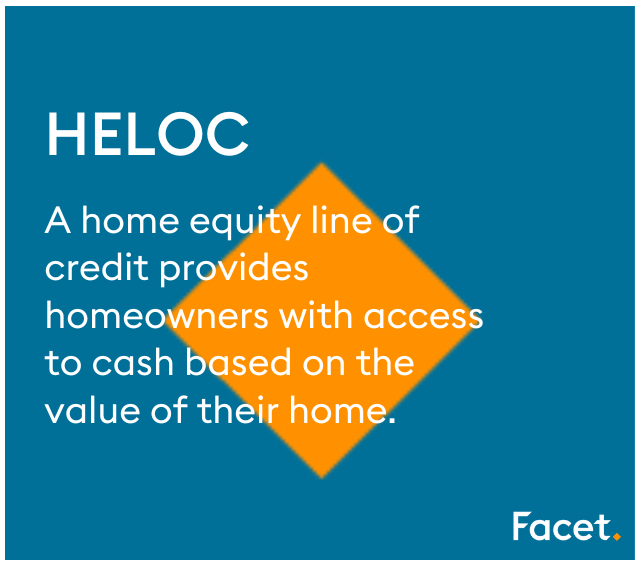
The information provided is based on the published date.
Key takeaways
- A home equity line of credit (HELOC) allows homeowners to tap into equity based on the value of their property
- HELOCs operate like a revolving credit line, with funds accessible via online transfers, bank card transactions, or checks provided by the lender
- HELOCs have a variable interest rate tied to an index, with a margin added by the lender based on the borrower's credit profile
- HELOCs are divided into a draw period (when funds can be accessed) and a repayment period (when principal and interest must be repaid)
Understanding home equity lines of credit (HELOCs)
A home equity line of credit (HELOC) is a financial product that provides homeowners with access to cash based on the value of their home.
It offers flexibility, convenience, and potential cost savings for borrowers looking to tap into their home's equity for various financial needs.
In this comprehensive guide, we will delve deeper into how a HELOC works, its benefits and considerations, the application process, and tips for responsible borrowing.

How do HELOCs work?
At its core, a HELOC is a kind of revolving credit, similar to a credit card. This financial instrument lets homeowners borrow against the equity in their property.
To calculate your home's equity, subtract the outstanding balance on your primary mortgage from the home's current market value.
For instance, if your home's market value is $500,000 and you owe $300,000 on your mortgage, your home equity would be $200,000.
(You can also use an online home equity calculator like this one.)
A HELOC gives you a maximum credit line based on a percentage of your home's equity. This credit line acts as a reserve from which you can draw funds as needed.
The flexibility of a HELOC allows you to access the funds in various ways, including online transfers, bank card transactions at ATMs or point-of-sale terminals (similar to debit cards), or by writing checks provided by the lender.
A HELOC does not have a fixed interest rate but rather a variable interest rate, often tied to an index such as the prime rate.
As the index rate fluctuates, so does the HELOC's rate and your monthly payments. However, since a HELOC is a secured loan, with your home serving as collateral, the interest rate is typically lower than that of an unsecured credit card.
To set the interest rate, the lender will add a markup, also known as the margin, to the index rate based on your credit profile and financial history.
A higher credit score can potentially result in a lower markup and more favorable terms. When exploring potential HELOC offers, be sure to inquire about the margin to understand how it will impact your interest rate and monthly payments.
Understanding the phases of a HELOC
A HELOC is divided into two distinct phases: the draw and repayment periods.
The draw period
During this initial phase, which usually spans around ten years, you can borrow funds from the available credit line up to the approved limit.
As you draw funds, your outstanding balance increases, and you must make minimum monthly payments.
The minimum payments during the draw period often cover only the interest accrued, though you can choose to make additional payments toward the principal if you wish.
The repayment period
After the draw period, the repayment period commences, typically lasting around 20 years.
During this period, you can no longer access additional funds from the credit line, and you must begin repaying both the principal and the interest. As a result, your monthly payments during the repayment period will likely increase compared to the draw period.
Budgeting and planning for the transition from the draw period to the repayment period is crucial, as the change in payment structure can lead to higher monthly obligations.
Moreover, at the end of the loan term, there may be a substantial lump sum, known as a balloon payment, covering any remaining principal not paid during the life of the loan.
To avoid this, consider refinancing with a new lender or making larger payments than the required minimum to reduce the principal faster.
Benefits and Considerations of a HELOC
HELOC benefits
- Access to funds: A HELOC provides a readily available source of funds, allowing homeowners to address various financial needs, such as home renovations, tuition expenses, debt consolidation, or unexpected emergencies. The ability to draw funds as needed offers convenience and financial flexibility.
- Lower interest rates: Since your home secures a HELOC, it typically offers lower interest rates than other unsecured loans, such as credit cards or personal loans. This can result in potential cost savings over time, especially when borrowing significant amounts.
- Tax deductibility: Sometimes, the interest paid on a HELOC may be tax-deductible, providing potential tax benefits for homeowners. However, tax laws and regulations can vary, so it's essential to consult a tax advisor to determine your eligibility for deductions.
- Improved credit scores: Responsible management of a HELOC can positively impact your credit score. On-time payments and maintaining a low credit utilization ratio demonstrate financial responsibility and may improve your credit score over time.
HELOC considerations and potential risks
- Variable interest rates: The adjustable interest rates associated with a HELOC mean that your monthly payment can change over time. If interest rates rise significantly, your monthly obligations may increase, potentially impacting your budget.
- Home as collateral: As a secured loan, a HELOC places your home at risk. Failure to repay the loan can result in foreclosure, potentially leading to the loss of your home.
- Balloon payment: Depending on your repayment strategy and the terms of the HELOC, you may face a sizable lump sum payment at the end of the loan term. Proper planning and budgeting are essential to avoid this potential financial burden.
- Debt accumulation: The accessibility of a revolving credit line can tempt some borrowers to accumulate excessive debt, leading to financial strain and difficulties in repayment.
- Additional fees: While HELOCs may offer lower interest rates, borrowers should be aware of potential fees, such as application fees, annual fees, or early termination fees, which can add to the overall cost of the loan.
Is a HELOC right for you?
Before pursuing a HELOC, it's essential to carefully evaluate your financial situation and goals to determine if it aligns with your needs. Consider the following factors.
Financial objectives
Clearly define your reasons for seeking a HELOC and how you plan to use the funds. Assess whether a HELOC is the most suitable financial tool to achieve your objectives.
Cash flow
Analyze your cash flow to ensure you can comfortably manage the monthly payments during the draw period and the repayment phase.
Repayment strategy
Plan for the transition from the draw period to the repayment period and consider strategies to minimize or eliminate the balloon payment at the end of the loan term.
Interest rate outlook
Evaluate the current and projected interest rate environment to understand how potential rate changes could impact your monthly payments and overall cost.
Responsible borrowing
Only borrow what you absolutely need and can afford to repay. Avoid accumulating excessive debt that could strain your financial situation.
Applying for a HELOC
Obtaining a HELOC follows a process similar to purchasing or refinancing a mortgage.
Here are the steps involved:
- Determine equity: Begin by calculating your home equity using a reliable home equity calculator. Most home equity lenders require homeowners to maintain a certain amount of equity, typically at least 15%, to qualify for a HELOC.
- Shop for lenders: Research and compare various HELOC lenders to find the best terms and rates that suit your financial needs.
- Gather documentation: Prepare the necessary documents in advance to expedite the application process. Standard documents include proof of income, credit history, home appraisal, and mortgage statements.
- Apply for the HELOC: Submit your application to the selected lender. Be prepared for a credit check and a thorough review of your financial information.
- Review the terms: Carefully review the disclosure documents provided by the lender. Pay close attention to the interest rate, draw period, repayment terms, fees, and any other relevant terms and conditions.
- Underwriting process: The lender will assess your creditworthiness and evaluate the value of your home to determine the approved credit limit and interest rate.
- Loan closing: Upon approval, you will finalize the HELOC agreement by signing the necessary paperwork to make the credit line available for use officially.
Responsibly managing your HELOC
Once you have secured a HELOC, responsible management is essential to maximize this financial tool while avoiding potential pitfalls. Here are some tips for effectively managing your HELOC.
Set a budget
Create a budget that includes your monthly HELOC payments, ensuring they fit comfortably within your overall financial plan.
Monitor rates
Keep an eye on the interest rate environment and be prepared for potential changes in your monthly payments.
Resist impulse borrowing
Avoid using a HELOC for unnecessary expenses or impulse purchases. Borrow money only when you have a clear purpose and financial need.
Plan for repayment
Develop a strategy to repay the borrowed funds, ideally during the draw period, to reduce the overall interest cost and minimize the balloon payment at the end of the loan term. Waiting for when the repayment period begins can be costly.
Monitor your credit
Regularly review your credit reports and scores to guarantee accuracy and identify any potential issues that may affect your creditworthiness.
Stay informed
Keep yourself informed about the terms and conditions of your HELOC, including any changes in interest rates, fees, or repayment options.
What's better, a home equity loan or a line of credit?
The best choice depends on your financial situation and needs.
A Home Equity Line of Credit (HELOC) operates as a flexible line of credit, allowing you to access the value of your home as you need it.
On the other hand, a home equity loan functions more like a traditional loan, providing a lump-sum withdrawal that is repaid in installments.
HELOCs generally come with variable interest rates, while home equity loans are typically offered with fixed interest rates.
Opting for a fixed rate can protect you from potential payment surprises in the event of rising interest rates. Consult your lender to determine the most suitable financing option for your specific needs.
Final word
A home equity line of credit can be a useful financial tool for homeowners seeking to tap into the equity in their homes.
Its flexibility, lower interest rates, and potential tax benefits make it an attractive option for various financial needs.
However, borrowers must approach a HELOC with careful consideration, planning, and responsible borrowing habits.
By understanding how a HELOC works, assessing your financial situation, and staying informed about the loan terms, you can make informed decisions that align with your long-term financial goals.
Facet
Facet Wealth, Inc. (“Facet”) is an SEC registered investment adviser headquartered in Baltimore, Maryland. This is not an offer to sell securities or the solicitation of an offer to purchase securities. This is not investment, financial, legal, or tax advice. Past performance is not a guarantee of future performance.


